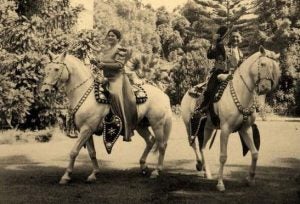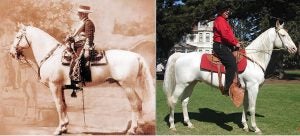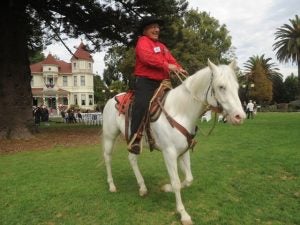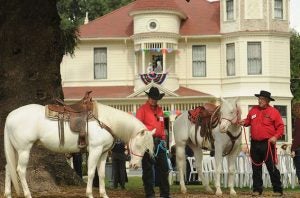Harold Parker has a deep love for Camarillo Whites, a breed of horses that marked his childhood memories and has defined his passions as an adult. As fires raged across California weeks ago, he drove to the bottom of the Wheeler Canyon and loaded his stallion, Panchito, trailering him safely from the flames. This was not, however, the first time Parker has saved the breed.
After spending his childhood with his great aunt Carmen Camarillo Jones on the Camarillo Ranch in California, Parker witnessed the slow dispersal of the ranch and with it, the Camarillo Whites he loved. Twelve years ago, he bought the last stallion born on the ranch, known as Panchito, and began his breeding program. Parker stands the stallion at stud for his own mares and a few outside horses as well. It was Panchito he purchased to continue the breed and Panchito he hauled out of a burning canyon. Parker is invested in continuing the breed; he is deliberate in not housing his Camarillo Whites all in the same location and has the stud’s semen stored in both California and Oklahoma.

Adolfo Camarillo started the breed after purchasing a stallion known as Sultan from the Miller and Lux Cattle Company in 1921 at the California State Fair. Camarillo bred primarily to Morgan mares when the breed was in the foundation stages.
He continued to breed that way until his death in 1958, Parker said. Camarillo would bring a string of Camarillo Whites to popular trail rides in the area for family and friends to ride and was a staple in the area’s parades. The horses, Parker said, were not just parade mounts but worked on the ranch as well. Some of Parker’s stallion clients breed Peruvian Paso mares and others to Standardbreds. Parker tends toward Quarter Horses and said the Camarillo White is a versatile breed and the “white wrapper” they have made famous, can be wrapped around any breed of horse.

Camarillo White horses have an open registry, but Parker said not every white horse is a Camarillo White. Horses qualifying as a Camarillo White are identified through a genetic test by the C4 mutation in addition to a handful of other prominent genetic defects specific to the breed.
By the early 1930s, the Camarillo Whites were well known for parades, and Parker said they were in attendance to celebrate the opening of the Brooklyn Bay Bridge, and were rumored to have been at the opening of the Golden Gate Bridge. The horses were also among the stars in the Hollywood Christmas Parade on Thanksgiving weekend. Most of the Camarillo Whites are located in Los Angeles and Ventura counties, making them truly a part of southern California.
“How they originally became involved in the Tournament [of Roses] Parade is unknown but they’re well known around southern California,” he said.

One of the best-known stallions was Pancho, trained by Meliton “Mellie” Ortiz, with whom Parker said no story about the Camarillo Whites would be complete. Ortiz, was the longtime trainer and caretaker of the Camarillo Whites.
“He was there from the ’30s up until my aunt passed away in the ’80s training, breeding, and taking them to parades,” he said. “He was the number one guy and lived to be 92 and was a huge fount of knowledge for all of us.”
Parker’s great aunt Carmen Camarillo Jones and his mother purchased Pancho from the ranch’s dispersal sale and gifted him to Ortiz who stood him at stud, eventually producing Panchito, now owned by Parker. Pancho, who was 7/8 Quarter Horse was the result of Camarillo Jones’ transition from her father’s Morgan breeding to Quarter Horses, which Parker has carried on, ensuring the continuation of the breed.

While no Camarillo Whites will appear in the Tournament of Roses Parade this year, it is Parker’s hope that they will eventually return.
The original ranch house is now owned by the city of Camarillo, and it is Parker’s hope that it may, one day, house Camarillo White horses on the small remaining acreage.



